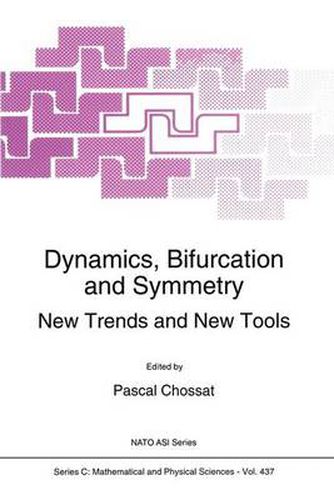Readings Newsletter
Become a Readings Member to make your shopping experience even easier.
Sign in or sign up for free!
You’re not far away from qualifying for FREE standard shipping within Australia
You’ve qualified for FREE standard shipping within Australia
The cart is loading…






This title is printed to order. This book may have been self-published. If so, we cannot guarantee the quality of the content. In the main most books will have gone through the editing process however some may not. We therefore suggest that you be aware of this before ordering this book. If in doubt check either the author or publisher’s details as we are unable to accept any returns unless they are faulty. Please contact us if you have any questions.
This book collects contributions to the conference Dynamics, Bifurcation and Symmetry, new trends and new tools , which was held at the Institut d'Etudes Sci entifiques de Cargese (France), September 3-9, 1993. The first aim of this conference was to gather and summarize the work of the European Bifurcation Theory Group after two years of existence (the EBTG links european laboratories in five countries via an EC grant). Thanks to a NATO ARW grant, the conference developed into an international meeting on bifurcation theory and dynamical systems, with the partic ipation of leading specialists not only from Europe but also from overseas countries (Canada, USA, South America). It was a great satisfaction to notice the active, and quite enthusiastic participation of many young scientists. This is reflected in the present book for which many contributors are PhD students or post-doc researchers. Although several big themes (bifurcation with symmetry, low dimensional dynam ics, dynamics in EDP’s, applications, … ) are present in these proceedings, we have divided the book into corresponding parts. In fact these themes overlap in most contributions, which seems to reflect a general tendancy in nonlinear science. I am very pleased to thank for their support the NATO International Exchange Scientific Program as well as the EEC Science Program, which made possible the suc cess of this conference.
$9.00 standard shipping within Australia
FREE standard shipping within Australia for orders over $100.00
Express & International shipping calculated at checkout
This title is printed to order. This book may have been self-published. If so, we cannot guarantee the quality of the content. In the main most books will have gone through the editing process however some may not. We therefore suggest that you be aware of this before ordering this book. If in doubt check either the author or publisher’s details as we are unable to accept any returns unless they are faulty. Please contact us if you have any questions.
This book collects contributions to the conference Dynamics, Bifurcation and Symmetry, new trends and new tools , which was held at the Institut d'Etudes Sci entifiques de Cargese (France), September 3-9, 1993. The first aim of this conference was to gather and summarize the work of the European Bifurcation Theory Group after two years of existence (the EBTG links european laboratories in five countries via an EC grant). Thanks to a NATO ARW grant, the conference developed into an international meeting on bifurcation theory and dynamical systems, with the partic ipation of leading specialists not only from Europe but also from overseas countries (Canada, USA, South America). It was a great satisfaction to notice the active, and quite enthusiastic participation of many young scientists. This is reflected in the present book for which many contributors are PhD students or post-doc researchers. Although several big themes (bifurcation with symmetry, low dimensional dynam ics, dynamics in EDP’s, applications, … ) are present in these proceedings, we have divided the book into corresponding parts. In fact these themes overlap in most contributions, which seems to reflect a general tendancy in nonlinear science. I am very pleased to thank for their support the NATO International Exchange Scientific Program as well as the EEC Science Program, which made possible the suc cess of this conference.